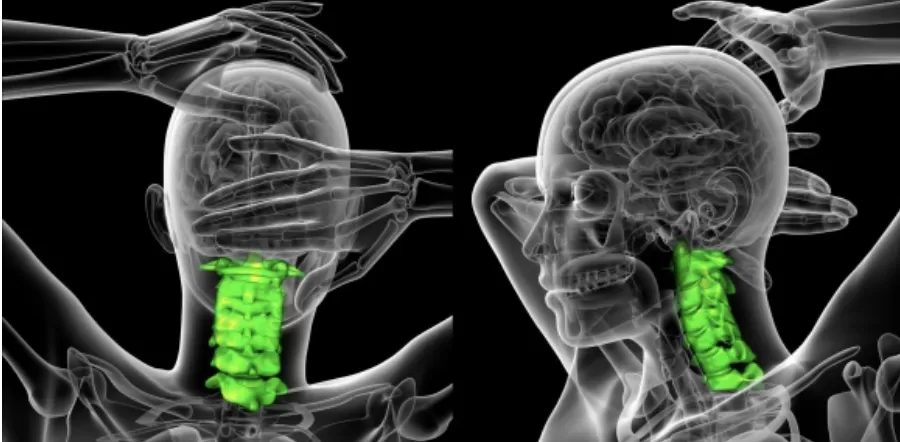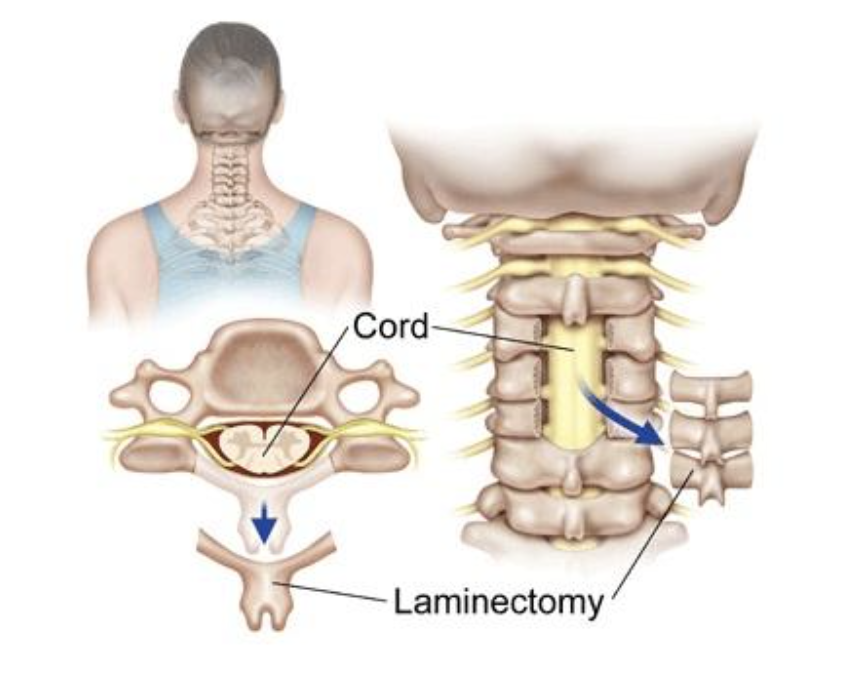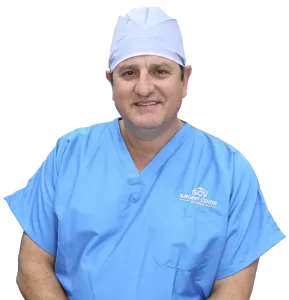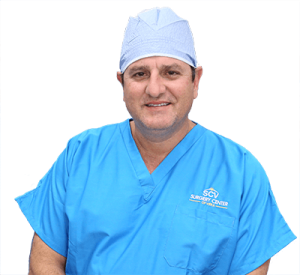
Shockingly, anywhere from one-third to half of the entire US population endures neck pain each year. Injury, as simple as muscle strain due to posture, causes the bulk of that pain. While muscle strain often resolves in the short-term, a growing number of Americans suffer from long-term, chronic pain.
If you suffer from neck pain and typical treatments prove ineffective, surgery may offer the solution you deserve. This article will discuss neck pain and explore the pros and cons of surgery as a solution.
Neck surgery is an orthopedic procedure performed on the cervical spine. The cervical spine is the part of the spine that makes up the back of the neck, running from the skull base to the clavicle.

Typically, these procedures aim to correct issues along the cervical spine, whether that means alleviating pressure on the nerves causing the discomfort or addressing spinal deformities.
Neck surgery can help you regain certain motor functions, alleviate pain, and help you return to your normal daily activities.
There are situations when cervical surgery is necessary and times when it is not. Five signs you may need neck surgery include:
If any of the following descriptions apply to you, it may be time for an MRI review by Deuk Spine Institute:
All surgeries come with risks, and neck surgery is no exception. Before undergoing any surgical procedure, it is crucial to understand the associated risks. There are also benefits to neck surgery, and it is equally important to know what these may be to make an informed decision on whether to proceed.
There are many advantages of neck surgery, including:
Although neck surgery has its advantages, there are also risks you need to consider. Risks of this type of surgery include:
Considering the advantages and disadvantages of neck surgery gives you an idea of what to expect before and after having the procedure.
Neck surgery can cost thousands of dollars. However, the exact amount of money you will pay for neck surgery may vary depending on the type of procedure you’re having performed and the insurance you have.
As a rule of thumb, the more complicated a surgery is, the more it will cost. Pricing varies significantly on an individual basis. Deuk Spine Institute offers a variety of financing options, and a Surgical Warranty is also available.
Click here to learn more about the anatomy of the spine in an education video by Deuk Spine Institute.
If you are searching for more visual educational content, explore the following links:
What is it: Deuk Laser Disc Repair is a minimally invasive procedure performed using an endoscope to reach the source of the pain without removing ligaments or stabilizing joints.
This form of surgery has been peer-reviewed, FDA approved, and published as a safe and effective treatment for back pain caused by bulging, herniated or degenerated disc(s), annular tears, and spinal stenosis.

Using a thin endoscope, the surgeon can see the damaged disc and use a precision laser to remove the damaged tissue causing the symptoms. The precision laser enables the surgeon to target the damaged tissue without damaging the surrounding bone and nerves. The damaged disc tissue is only 5 to 10% of the total disc tissue in most cases. Therefore, the healthy disc can be left in place, and there is no need for spinal implants like screws, rods, and artificial discs.
Fusions are also unnecessary, which means patients can stand and walk around within minutes after the surgery. Deuk Laser Disc Repair is by far the safest form of back and neck surgery. It is performed as an outpatient procedure requiring no hospital stay and enables patients to avoid the complications of open and anterior surgeries.
Deuk Laser Disc Repair effectively treats sciatica, pinched nerves, herniated discs, bulging discs, spinal stenosis, symptomatic cervical disc disease, and other conditions that cause intense chronic pain. With no hospital stay required, no opioids or narcotic pain killers, it’s the safest form of surgery with the quickest recovery time. For additional information about the effectiveness and reliability of Deuk Laser Disc Repair, click here.
Recovery time: Deuk Laser Disc Repair is a minimally invasive procedure with one of the fastest recovery times for a procedure of its type. The precision laser procedure avoids drilling, fusing, or implanting, and patients can walk out of the recovery room within an hour, pain-free.
The surgical incision is between 4-7 millimeters long and typically heals within days without internal damage or scarring. Most patients report that they can go about their everyday lives and return to work within a week.
Surgeons recommend that patients use hot/cold packs if they experience pain during recovery and are advised to contact the facility if their pain increases or they experience any redness or swelling.
Benefits of Deuk laser Disc repair:
Risks of Deuk laser disc repair:
Cost: Request a free MRI review for a quote.
Where to get it: Deuk Spine Institute
The different types of cervical spinal fusion surgery include:
What is it: Spinal fusion surgery is a procedure that involves permanently connecting or ‘fusing’ two or more vertebrae together.

A spinal fusion is a procedure that involves fusing two or more vertebrae to produce a single, solid bone, limiting movement between vertebral elements. When the vertebral segments are fused with a bone graft, the motion at one or more vertebrae is stopped,
Bone grafts are either taken from the patient’s hip (during surgery) or extracted from a cadaver bone. An artificial graft can also be manufactured ahead of time. However, it’s important to note that bone grafts commonly cause unwanted spinal surgery complications. The surgeon may use metal plates, rods, or screws to ensure the proper healing and fusing of the vertebrae. These implants may also cause unwanted infections or dislocation during recovery.
Recovery time: Typically, spinal fusion surgery requires a long recovery time. When considering this surgery, most patients must carefully evaluate this reason.
It will usually take between 3-6 months for the bones to fuse completely. The first 1-3 months are the most critical in the healing process because the fusion is establishing itself during this time. After six months, patients can resume normal activities upon receiving approval from their surgeon. The bone fusion will continue to solidify over the year following the procedure.
At most facilities, patients will spend 2-4 days in the hospital being monitored before being cleared to return home. However, here at the Deuk Spine Institute, we use advanced surgical techniques and perform spinal fusions as outpatient procedures, allowing patients to go home the same day.
Patients at Deuk Spine Institute are encouraged to work with a physical therapist to ensure they are gradually reintroducing motion into their necks. Most patients can drive off opioids within four weeks and can return to most jobs within six weeks.
Benefits of spinal fusion surgery:
Risks of spinal fusion surgery:
Cost: $60,000 – $100,000
Where to get it: Deuk Spine Institute
What is it: Anterior Cervical Discectomy and Fusion (ACDF) is a type of neck surgery designed to relieve pressure on the spinal cord or the root nerves by removing a damaged disc.
There are two parts to this surgery:
An ACDF is most commonly performed to treat asymptomatic cervical herniated discs. It’s also offered as a solution for cervical degenerative disc disease, to remove bone spurs, and to relieve the symptoms of cervical spinal stenosis.

During the procedure, the surgeon makes a surgical incision on the front of the patient’s neck, providing direct access and clear visualization of the cervical disc(s) causing the problems. Accessing the disc through the front of the neck also provides a relatively uncomplicated pathway and is known to cause less postoperative pain. Only one vestigial muscle needs to be cut to give the surgeon access to the spine.
Once the surgeon has direct access to the damaged cervical disc(s), they are removed, and a bone graft is placed for fusion between the vertebrae. Usually, the surgeon must also fuse the vertebrae with a metal plate to ensure proper healing.
Recovery time: Typically, patients return home the same day of the surgery or the following day. Some patients will be monitored to assess the need for pain medication and to make sure they’re able to eat and drink sufficiently.
It’s normal to feel pain in and around the area of the surgery and numbness and tingling in the arms and shoulders. Patients may also experience difficulty swallowing as the procedure takes place in the neck.
The first 1-3 months are critical in the recovery process as the bone graft is established. The graft will not fully fuse with the vertebrae until at least six months have passed. Results will vary, taking into account a patient’s health condition, how the procedure went, and how their post-op recovery has gone.
Benefits of ACDF Cervical Spine Fusion surgery:
Risks of ACDF Cervical Spine Fusion surgery:
Cost: Request a free MRI review for a quote.
Where to get it: Deuk Spine Institute
What is it: Posterior Cervical Discectomy and Fusion (PCDF) is a similar procedure to an Anterior Cervical Discectomy and Fusion (ACDF), with the difference being that the surgeon uses a posterior approach (entering from the rear of the neck).

Some spine surgeons prefer to enter from the rear of the neck, and for some neck conditions or patients, this approach is necessary. A PCDF is most commonly considered for disc herniations that are lateral to the spinal cord. It is a helpful procedure for relieving pressure or compression on the nerve roots in the cervical spine.
The procedure involves making a small surgical incision at the back of the neck to access the spine and removing the disc(s) and bone material that compresses the nerve roots. By approaching the cervical disc herniation through the rear of the neck, a bone fusion is often unnecessary, and the healing process is quicker.
A PCDF is a minimally invasive procedure that involves the use of highly specialized surgical instruments. The surgical incision is small, and recovery time is relatively quick.
Recovery time: If no bone fusion was needed, patients could expect to walk out of the institute either the same day or the following day.
Pain medication may be required for 2-4 weeks, and patients will not be able to drive, bend, or perform any strenuous activities during this time. Your surgeon will recommend physical therapy, and most patients can return to work within 2-4 weeks, depending on their role and how their recovery period went.
Benefits of PCDF Cervical Spine Fusion surgery:
Risks of PCDF Cervical Spine Fusion surgery:
Cost: Request a free MRI review for a quote
Where to get it: Deuk Spine Institute
What is it: There are two different types of procedures:
A Laminectomy is a surgical operation performed as a treatment for patients suffering from Spinal Stenosis. While typically occurring in a hospital setting, administering a Laminectomy is considered a relatively invasive medical procedure due to the nature of open back surgery and the removal of bone. Recovery time for a laminectomy can be up to six months.
At Deuk Spine Institute, we have found a way to eliminate the need for traditional Laminectomies through the use of minimally invasive laser surgery, which drastically increases success rates, reduces complications, and decreases the number of time patients spends in recovery.

Often performed alongside a Foraminotomy and traditional spinal fusion, a Laminectomy is essentially the removal of the lamina or compressive matter in the spine that may be damaging the spinal cord or spinal nerves. Typically involving a large incision and the moving of muscle, skin, and ligaments, Laminectomy surgery allows doctors to relieve pressure on the spinal cord or nerves by removing the lamina bone or bone spurs, causing Spinal Stenosis. The problem with this method is that it requires the risk of collateral damage to soft tissues in the area to reach the problematic region.
Recovery time: Patients can typically leave the hospital 2-4 days after a laminectomy/laminotomy procedure.
Most patients rely on powerful pain-relieving medications for the first few weeks of recovery, and some surgeons recommend stool softeners for the first few days of recovery. You can expect scar tissue to form around the spine and nerves. The activity must be kept to a minimum during the first month at home. Your surgeon or physical therapist will recommend the best exercise and movements to help restore the whole movement and maximize your recovery, which may take months or even years.
How long a full recovery takes is dependent on a patient’s general health, how the procedure went, and how the recovery is progressing. Typically, full recovery takes anywhere between 2 to 6 months. Some patients will feel a small degree of stiffness for the rest of their lives.
Benefits of Laminectomy surgery:
Risks of Laminectomy surgery:
Cost: $50,000 – $150,000
What is it: Artificial disc replacement surgery is a procedure that removes a damaged or deteriorated disc and replaces it with an artificial disc. This procedure is typically recommended for patients suffering from reoccurring back pain for six months or longer who have exhausted all non-surgical procedures without finding relief.

The vertebrae in the spine are separated by intervertebral discs, allowing movement and protecting the vertebrae from friction. With age, these discs may become damaged or begin to deteriorate, resulting in back pain.
To perform this procedure, the surgeon accesses the hard disc through the abdomen using an anterior approach. With this approach, the surgeon gently moves organs aside to gain access to the spine. With a clear pathway to the disc causing the problems, the surgeon will remove the disc and replace it with an artificial one designed to mimic the motion of a natural disc.
Artificial disc surgeries are generally regarded as one of the most dangerous approaches to spine surgery as several known complications may occur.
Recovery time: Patients can expect to stay in hospital for 2-3 days before returning home. They can expect to return to work and regular activities after six weeks, depending on how the procedure went and their recovery.
The main benefit of this form of surgery is that no bones are fusing; therefore, patients can expect to experience full mobility of the midsection shortly after surgery.
It is recommended that patients avoid any movement that may hyperextend the back for at least six weeks following surgery. In most cases, surgeons will prescribe physical therapy.
Benefits of artificial disc surgery:
Risks of artificial disc surgery:
Cost: $14,000 to $38,000.
Where to get it: Request a free MRI review to see if this procedure is correct for you.

Before undergoing surgery, carefully review each of these questions individually as they can affect your reaction to the anesthesia used during surgical procedures:
Always consult your doctor before undergoing any type of anesthesia.
Post-operative pain is a common and regrettable side effect of any invasive surgery. It is not guaranteed, but it is also not uncommon. Moreover, it is not inherently an indication of the success or failure of the operation. It can, however, be effectively managed by working with specialists and sticking to a recovery plan.
We at Deuk Spine Institute strive to minimize the invasiveness of our surgeries, thereby reducing post-operative pain as much as possible. Thanks to our technique and experience, we are largely successful in doing so. The relief of the underlying pain is often immediate, and patients who underwent outpatient procedures can spend that very same night at home, in their bed, pain-free.
For more information about Deuk Spine Institute and begin your path towards living a pain-free life → , click here.

